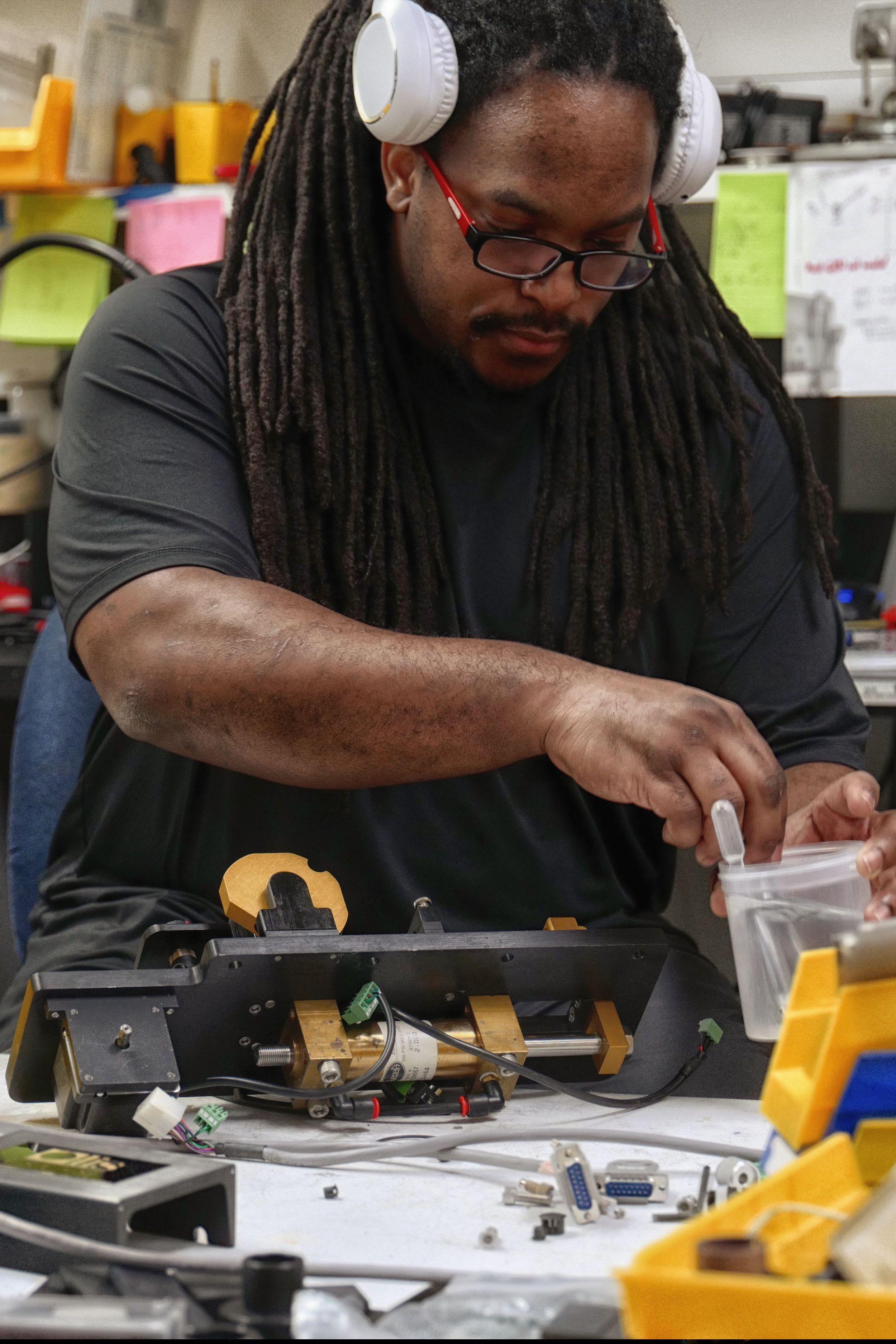Some Ideas on Uv/vis You Should Know
Table of ContentsSpectrophotometers - QuestionsTop Guidelines Of Uv/visThe Definitive Guide for Uv/vis/nirSome Ideas on Circular Dichroism You Should KnowThe smart Trick of Uv/vis That Nobody is Discussing10 Simple Techniques For Spectrophotometers5 Simple Techniques For Uv/vis/nirThe Spectrophotometers StatementsThe 7-Second Trick For Circularly Polarized LuminescenceGetting The Uv/vis/nir To WorkGet This Report on Circular DichroismThe 15-Second Trick For Uv/vis/nirNot known Incorrect Statements About Uv/vis
It is then scanned through the sample and the reference options. Fractions of the occurrence wavelengths are transferred through, or shown from, the sample and the reference. The resultant light strikes the photodetector gadget, which compares the relative strength of the two beams. Electronic circuits transform the relative currents into direct transmission percentages and/or absorbance/concentration worths.The transmission of a recommendation substance is set as a standard (information) value, so the transmission of all other compounds are tape-recorded relative to the initial "zeroed" substance. The spectrophotometer then converts the transmission ratio into 'absorbency', the concentration of particular components of the test sample relative to the preliminary compound.
Because samples in these applications are not readily available in big quantities, they are especially matched to being analyzed in this non-destructive method. In addition, precious sample can be conserved by using a micro-volume platform where as little as 1u, L of sample is required for complete analyses. A short explanation of the treatment of spectrophotometry includes comparing the absorbency of a blank sample that does not include a colored compound to a sample which contains a colored compound.
The Buzz on Circularly Polarized Luminescence
In biochemical experiments, a chemical and/or physical home is chosen and the procedure that is used is particular to that home in order to derive more information about the sample, such as the amount, pureness, enzyme activity, and so on. Spectrophotometry can be utilized for a variety of techniques such as identifying optimum wavelength absorbance of samples, determining optimal p, H for absorbance of samples, identifying concentrations of unknown samples, and determining the p, Ka of numerous samples.: 21119 Spectrophotometry is likewise a practical procedure for protein filtration and can also be used as a technique to produce optical assays of a substance.
It is possible to know the concentrations of a two part mixture using the absorption spectra of the standard solutions of each component. To do this, it is necessary to know the extinction coefficient of this mix at two wave lengths and the extinction coefficients of services that consist of the known weights of the two parts.

Unknown Facts About Uv/vis
Area. The concentration of a protein can be approximated by determining the OD at 280 nm due to the presence of tryptophan, tyrosine and phenylalanine.
Nucleic acid contamination can also interfere. This technique needs a spectrophotometer efficient in determining in the UV area with quartz cuvettes.: 135 Ultraviolet-visible (UV-vis) spectroscopy includes energy levels that delight electronic transitions. Absorption of UV-vis light thrills particles that are in ground-states to their excited-states. Noticeable region 400700 nm spectrophotometry is utilized extensively in colorimetry science.
These curves can be used to evaluate a new batch of colorant to check if it makes a match to specs, e
Traditional visible conventional noticeable area not detect if find colorant or the base material has fluorescence. This can make it tough to manage color issues if for example one or more of the printing inks is fluorescent. There are 2 major setups for visual spectrum spectrophotometers, d/8 (round) and 0/45.
Scientists utilize this instrument to determine the quantity of substances in a sample. In the case of printing measurements two alternative settings are frequently used- without/with uv filter to control much better the impact of uv brighteners within the paper stock.
7 Easy Facts About Uv/vis Explained
Some applications need little volume measurements which can be carried out with micro-volume platforms. As explained in the applications section, spectrophotometry can be used in both qualitative and quantitative analysis of DNA, RNA, and proteins. Qualitative analysis can be used and spectrophotometers are used to record spectra of compounds by scanning broad wavelength regions to figure out the absorbance residential or commercial properties (the strength of the color) of the compound at each wavelength.

The 5-Second Trick For Circularly Polarized Luminescence
One major element is the type of photosensors that are available for different spectral regions, but infrared measurement is likewise tough blog because essentially whatever produces IR as thermal radiation, particularly at wavelengths beyond about 5 m. Another problem is that numerous products such as glass and plastic take in infrared, making it incompatible as an optical medium.
Recovered Dec 23, 2018. Essential Laboratory Approaches for Biochemistry and Biotechnology (2nd ed.). The essential guide to analytical chemistry.
Oke, J. B.; Gunn, J. E.
Circular Dichroism Can Be Fun For Anyone

1021/ac50048a728. ISSN0003-2700. Ninfa AJ, Ballou DP, Benore M (2015 ). Essential Laboratory Techniques for Biochemistry and Biotechnology (3, rev. ed.). Hoboken, NJ: Wiley & Sons. p. 77. ISBN9780470924525. OCLC915641828. "Fully Automatic Double Beam - Atomic Absorption Spectrophotometer (AA 8000)". Laboratory Equipment. Labindia Analytical Instruments Pvt. Ltd. "Spectrophotometry Applications and Basics".
Uv/vis/nir Fundamentals Explained
Retrieved Jul 4, 2018. Trumbo, Toni A.; Schultz, Emeric; Borland, Michael G.; Pugh, Michael Eugene (April 27, 2013). "Applied Spectrophotometry: Analysis of a Biochemical Mix". Biochemistry and Molecular Biology Education. 41 (4 ): 24250. doi:10. 1002/bmb. 20694. PMID 23625877. (PDF). www. mt.com. Mettler-Toledo AG, Analytical. 2016. Recovered Dec 23, 2018. Cortez, C.; Szepaniuk, A.; Gomes da Silva, L.
"Exploring Proteins Filtration Techniques Animations as Tools for the Biochemistry Mentor". Journal of Biochemistry Education. 8 (2 ): 12. doi:. Garrett RH, Grisham CM (2013 ). Biochemistry. Belmont, CA: Cengage. p. 106. ISBN 978-1133106296. OCLC 801650341. Holiday, Ensor Roslyn (May 27, 1936). "Spectrophotometry of proteins". Biochemical Journal. 30 (10 ): 17951803. doi:10. 1042/bj0301795.
PMID 16746224. Hermannsson, Ptur G.; Vannahme, Christoph; Smith, Cameron L. C.; Srensen, Kristian T.; Kristensen, Anders (2015 ). "Refractive index dispersion noticing using a range of photonic crystal resonant reflectors". Applied Physics Letters. 107 (6 ): 061101. Bibcode:2015 Ap, Ph, L. 107f1101H. doi:10. 1063/1. 4928548. S2CID 62897708. Mavrodineanu R, Schultz JI, Menis O, eds.
Everything about Uv/vis/nir
U.S. Department of Commerce National Bureau of Standards unique publication; 378. Washington, D.C.: U.S. National Bureau of Standards.
The procedure starts with a regulated light that brightens the examined sample. When it comes to reflection, as this light connects with the sample, some is soaked up or emitted. The given off light journeys to the detector, which is examined, quantified, and provided as industry-standard color scales and indices.
Industry governing bodies usually specify particular metrics for specific products, such as Tomato and Coffee indices. The streamlined mathematics appears like this: Where R is the reflection coefficient. All terms are examined over the noticeable spectrum from 400 to 700 nm. In the case of transmission, when the light communicates with the sample, it is either absorbed, reflected, or sent.
The Only Guide for Uv/vis/nir
Examples include APHA (American Public Health Association) for watercolor and purity analysis, ASTM D1500 for petrochemical color analysis, edible oil indices utilized in food, and color analyses of drinks. The simplified math appears like this:. Where T is the transmission coefficient. All terms are examined over the noticeable spectrum from 400 to 700 nm.
Image Credit: Matej Kastelic/ Dr. Arnold J. Beckman and his associates at the National Technologies Laboratories first developed the spectrophotometer in 1940. In 1935 Beckman established the company, and the discovery of the spectrophotometer was their most ground-breaking invention. Dr. Bruce Merrifield, a Nobel prize-winning biochemist, mentioned that the creation of the spectrophotometer was "probably the most crucial instrument ever developed towards the advancement of bioscience." Before the discovery of the spectrophotometer, chemical analyses took weeks to finish, with 25% accuracy.
The Ultimate Guide To Circularly Polarized Luminescence
99% precision. Gradually, researchers kept enhancing the spectrophotometer design to enhance its performance. For example, the UV abilities of the model B spectrophotometer were improved by changing the glass prism with a quartz prism. Ultimately, the Model DU was produced, including a hydrogen lamp and other improvements. This instrument was utilized in industrial labs, centers, and chemistry and biochemistry departments.
Usually, a spectrophotometer is made up of two instruments, namely, a spectrometer and a photometer. A fundamental spectrophotometer includes a light source, a monochromator, a collimator for straight light beam transmission, a cuvette to position a sample, and a photoelectric detector.
Excitement About Circularly Polarized Luminescence
There are different kinds of spectrophotometers in various sizes and shapes, each with its own function or performance. A spectrophotometer determines just how much light is reflected by chemical parts. UV/Vis/NIR. It determines the difference in light strength based on the overall quantity of light presented to a sample and the quantity of light beam that goes through the sample option
A spectrophotometer is used to identify the concentration of both colorless and colored solutes in an option. This instrument is utilized to determine the rate of a reaction.